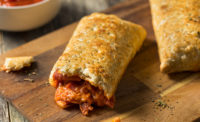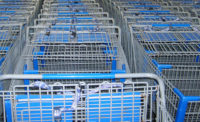Coming Attractions
By Sam Gazdziak, Senior Editor
Some of the latest packaging innovations will benefit the supermarket deli department.
Since the food options at retailers’ deli departments have grown increasingly varied, it was a natural development that an array of packaging options would follow. Grocery stores have more options than ever as far as packaging their fresh deli products, although the packaging has to meet the critical test of functionality.
Dan Emery, vice president of sales and marketing, for Pittsburg, Texas-based Pilgrim’s Pride, says that consumers’ packaging needs are pretty basic. “The big issues are portability, resealability, food safety and cost,” he explains. “The retailer is looking to get the consumer to take something home without the packaging being a major cost of that product, yet it’s still got to meet all those objectives.”
“A couple of years ago, a study found that the average American household throws away $380 worth of spoiled food each year,” says Alan Hiebert, education information specialist for the International Dairy Deli Bakery Association. “Obviously, not all of that waste is the result of packaging problems, but any product that can help increase shelf life should be well-received by deli consumers.”
Identifying the consumers’ needs is a simple enough task. Finding the packaging that helps to meet all those needs is the tricky part. There is a wealth of packaging options available, and each has advantages and disadvantages.
“Deli packaging is becoming more and more important due to the growth trend of prepackaged meats versus sliced at the deli,” explains Stephen Meli, national accounts manager for Pactiv, located in Lake Forest, Ill. He says that upon settling on packaging that offered convenience and freshness, processors have tried a variety of styles, including adding a press-to-close option. “Soon after that, slider became the preferred packaging style, giving way to tubs. We have seen a recent push in the marketplace to get back to slider packages. We feel that this is due to cost, convenience and sustainability. Tubs are more expansive and take up more space in the refrigerator and in the cupboard.”
Hiebert says that some companies are exploring ways to extend shelf life, including adding invisible and tasteless edible films that can resist bacteria growth. “Other deli meat processors are packaging their products at high pressure, which can dramatically increase shelf life without chemical additives. And some packaging companies have developed labels that have visible indicators to alert consumers of high bacteria levels.” He notes that many of the cutting-edge technologies are cost-prohibitive or impractical in-store use; a grocery store can’t package sliced-to-order meats at high pressures, for example. “But they are examples of where packaging is headed,” he notes.
Packaging versatility
Deli packaging needs to more than simply add shelf life, in many cases. Consumers are continuing to turn to a supermarket’s deli section to provide hot meals, and the packaging has to accommodate that need. “Today, many consumers are looking for ready-to-eat deli meals delivered in packages that can go from the oven to the microwave to the table and to the refrigerator,” Hiebert says.
Tara Downing, product manager for Robbie Mfg., based in Lenexa, Kan., says that the days of big-basket shopping will decrease as the baby boomer generation continues to age. “Consumers don’t want to spend their entire evening shopping, preparing a meal and cleaning the kitchen, nor do they have the 20 minutes to wait in line to receive their meal at the deli. Convenient pre-packaged meal solutions make it easy and possible for buyers to gather their items and still have time to do other things in the evening.”
Cheryl Miller Balster, operations manager at Menasha, Wis.-based Flair Packaging International, says that rotisserie packaging requires special materials to be able to withstand high temperatures for long periods of time. “We chose film structures that can withstand those temperatures (often polyester laminated to cast polypropylene), that reduces fog (contains anti-fog) and maintain optimal stiffness so that it merchandises well after time in a deli warmer case,” she says.
Functionality has to be included in any form of deli packaging as well, and Balster says that Flair keeps the customer in mind when developing products. “Customers need to be able to get their products back out of the package quickly and efficiently without burning themselves or causing spills,” she adds.
Downing says that consumers are becoming more and more sophisticated, to the point that a great deli-made meal now needs to be accompanied by enhanced packaging, “packaging that offers such benefits as preprinted reheating and storage instructions, as well as nutrition information. Packaging that employs easy transportation and safety features that the package will stay closed.”
She adds that processors are looking to differentiate their products in the deli section with products that will convey useful information to the consumer, such as the fact that the product is convenient to prepare, fresh, and easy to transport to the table, making it worth the price. “With continued advancement is printing, film structures and zipper closures, flexible packaging will be the package of choice for retailers to stay on the cutting edge to provide value-added conveniences to consumers,” Downing predicts.
Emery says that retailers and processors are doing a good job of supplying product to consumers, whether in lidded domes or flexible pouch alternatives. Pilgrim’s Pride typically ships its product to retailers in brown boxes, and the retailer prepared and packages it. The company is able to provide help when needed, though. “If a retailer says, ‘We want a 22-ounce package that’s prepackaged,’ we’ll prepackage a tray or do something custom,” he notes. “In many cases, the retailer is choosing the package, but we might help them design the package. For many customers, we help them design the sleeve that they put around the dome that the rotisserie chicken comes in.” Pilgrim’s Pride can also provide posters and counter cards, to help customize a customer’s deli program. “It’s not really [food] packaging, but it’s packaging the deli,” Emery says. After all, even the most innovative of food packaging will fail if nobody’s enticed into buying products from the deli.
New packaging developments
Hiebert says that consumers are looking for environmentally friendly alternatives, which in some instances involves buying products with less packaging when possible. He says that the packaging industry is moving more toward green practices.
“Polymers made from corn dextrose can make excellent plastic containers that can be composted,” he says. “Deli meats sold in reusable plastic containers can eliminate the need for consumers to buy additional plastic products. Some delis are offering the option of paper packaging rather than plastic, and some large consumer packaged goods manufacturers have taken the initiative to increase the recycling rates of their aluminum and plastic packages.”
Robbie Mfg., noting that interest in both prepared meals and pouch packaging is on the rise, is promoting the fact that its Hot N Handy Value Pack can help processors succeed in the deli department with a turnkey packaging solution. “Processors want packaging which is custom-designed to fit their product and with their brand message, and now they can have it packed right in with the product before shipping it directly to the deli. Processors already in the supermarket can now expand their presence into the deli with this value-added packaging solution,” Downing says.
Flair’s Balster says that the company’s vapor release pouch (VRP), released last year, is a self-venting stand-up pouch that is an alternative to a rigid microwaveable container. “Consumers microwave the pouch while it is still sealed, and it self-vents, eliminating spills and explosions in the microwave,” she says. “It even contains two ‘hold-here’ tabs so that consumers can remove it from the microwave how and not burn themselves.” It also can satisfy consumers’ desire for less waste with their packaging.



Report Abusive Comment